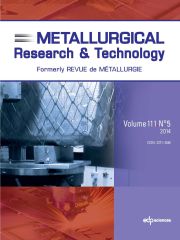Article contents
Numerical prediction of the effects of material properties onstrain behavior during equal channel angular pressing
Published online by Cambridge University Press: 22 November 2013
Abstract
Equal channel angular pressing is both a novel and an industrialized process among severeplastic deformation methods to fabricate ultra-fine-grained metals and alloys.Verification of a three-dimensional finite element model which compares various strengthcoefficients and strain-hardening exponents (virtual materials) defined for the plasticdeformation behavior of materials was performed with experimental tests. The virtualprocess numerically analyzed the effects of the strain behavior and pressing force. Theresults show that strength coefficient enhancement leads to decreased effective strainvalue, heterogeneous strain distribution and higher pressing force, and an increment inthe strain-hardening exponent results in lower pressing force. However, this parameterdoes not have an obvious effect on the effective strain magnitude and strain dispersaluniformity. Furthermore, the highest imposed effective strain, the best straindistribution homogeneity and the lowest required punch load were achieved for the deformedmaterial with the lowest strength coefficient and highest strain-hardening exponent.
Information
- Type
- Research Article
- Information
- Copyright
- © EDP Sciences 2013
References
- 3
- Cited by

